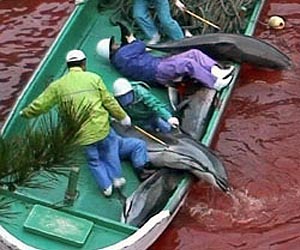Dolphins escape as nets are cut during Japan's annual hunt
by Staff Writers Tokyo (AFP) Sept 29, 2010
Japanese police have launched a probe after nets on holding pens for dolphins in the coastal town of Taiji were cut during an annual hunt, possibly by foreign activists, a press report said Wednesday. They are looking into whether the incident is connected with a statement posted on the website of Black Fish, a European conservation organisation, Kyodo news agency quoted investigators as saying.
The statement said the group's divers had cut the nets of six pens holding dolphins caught during the hunt which started on September 2, the report added.
A number of dolphins were able to swim back out to sea as a result, the statement said.
Taiji, located on the western Japanese peninsula of Kii, has drawn worldwide attention after a US documentary film, The Cove, which described the slaughter of dolphins there, won an Oscar for best documentary this year.
Every year, fishermen in Taiji herd about 2,000 dolphins into a shallow bay, select several dozen for sale to aquariums and marine parks and harpoon the rest for meat.
On September 2, animal rights activists protested against the dolphin hunt in a rally outside the US embassy in Tokyo, calling on President Barack Obama to pressure the country over the issue.
Ric O'Barry, star of The Cove, handed a petition with 1.7 million signatures from more than 150 countries to US embassy officials.
Source:
http://www.care2.com/news/member/430267290/2460152
Read more
 |
Japanese police have launched a probe after nets on holding pens for dolphins in the coastal town of Taiji were cut during an annual hunt, possibly by foreign activists, a press report said Wednesday. They are looking into whether the incident is connected with a statement posted on the website of Black Fish, a European conservation organisation, Kyodo news agency quoted investigators as saying.
The statement said the group's divers had cut the nets of six pens holding dolphins caught during the hunt which started on September 2, the report added.
A number of dolphins were able to swim back out to sea as a result, the statement said.
Taiji, located on the western Japanese peninsula of Kii, has drawn worldwide attention after a US documentary film, The Cove, which described the slaughter of dolphins there, won an Oscar for best documentary this year.
Every year, fishermen in Taiji herd about 2,000 dolphins into a shallow bay, select several dozen for sale to aquariums and marine parks and harpoon the rest for meat.
On September 2, animal rights activists protested against the dolphin hunt in a rally outside the US embassy in Tokyo, calling on President Barack Obama to pressure the country over the issue.
Ric O'Barry, star of The Cove, handed a petition with 1.7 million signatures from more than 150 countries to US embassy officials.
Source:
http://www.care2.com/news/member/430267290/2460152




















 "This would lead to more grass fires, which would further diminish the quality of grazing by volatizing minerals, and the ecosystem could flip into being a source of atmospheric CO2," the scientists said.
"This would lead to more grass fires, which would further diminish the quality of grazing by volatizing minerals, and the ecosystem could flip into being a source of atmospheric CO2," the scientists said.